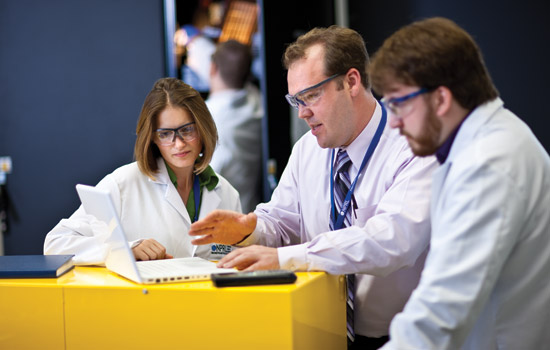Research Team Helps to Create the Next Generation of Solar Cells
Professor Seth Hubbard earns Early Career Award from National Science Foundation
John Myers
Seth Hubbard, assistant professor of physics and microsystems engineering (center), analyzes the results of a solar characterization test with Chelsea Plourde, a research associate in the Nanopower Research Labs, and Stephen Polly, a doctoral student in microsystems engineering. The team is testing how solar cells will perform under both terrestrial and extraterrestrial conditions.
Solar cells are currently used in a host of high-grade applications and power numerous satellites and the space shuttle. Now, new advancements in nanotechnology are improving the efficiency of these power generators, which could ultimately increase their commercial use throughout society.
A research team at Rochester Institute of Technology’s NanoPower Research Labs is currently working with NASA’s Glenn Research Center to improve the manufacture of high concentration photovoltaics. Photovoltaics are solar cells with significant power capacity and increased efficiency over previous applications. Rep. Eric Massa recently announced additional funding for the project provided through a grant from the National Science Foundation.
“I am committed to supporting green energy because not only is it good for our environment, but also because our country has been dependent on foreign sources of energy for too long,” Massa says. “RIT is doing cutting-edge research into safe, alternative forms of energy, something our country desperately needs. I'm proud to announce this funding so that we can continue to build upon an already strong program that has great potential both economically and environmentally.”
The grant was through the National Science Foundation’s Faculty Early Career Development Program and was awarded to Seth Hubbard, assistant professor of physics at RIT, who is the lead researcher on the project.
“I am extremely honored to have received this recognition and am very excited about where this research is heading,” notes Hubbard. “Our work with NASA has been extremely fruitful and I look forward to taking the next steps in enhancing the use of high concentration photovoltaics for both space and commercial applications.”
RIT’s partnership with NASA is expected to further advance the use of nanostructured materials for solar energy harvesting. Team members are specifically investigating the use of quantum dots, a high-grade semiconductor with unique properties, in improving the efficiency capabilities of high concentration photovoltaics. Students also will have the opportunity to spend the summer at Glenn Research Center's Photovoltaics and Power Technologies Branch, learning solar cell characterization techniques.
“Our work with NASA is helping to advance solar energy applications while also offering our students a unique opportunity to participate in cutting edge research in a real-world setting,” notes Paul Stiebitz, director of the NanoPower Research Laboratories. “This additional funding will not only assist us in moving our research forward, but will also help train the next generation of scientists and engineers and further the integration of solar power generation in a host of societal applications.”













